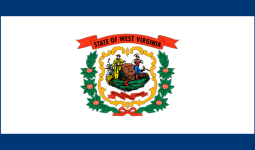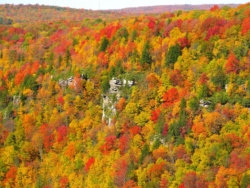West Virginia
West Virginia is a U.S. state located in the Appalachian region of the Southern United States.. It is bordered by Kentucky and Ohio to the west; Pennsylvania and Maryland to the north, and Virginia to the south.
- ABBREVIATION: WV
- NICKNAME: The Mountain State
- POPULATION: 1,854,304 (2013 est.)
- CAPITAL: Charleston
- STATE BIRD: Cardinal
- STATE FLOWER: Rhododendron
- AREA: 24,230 sq. mi.
- TIME ZONE: Eastern
- ENTERED UNION: June 20, 1863
- ALTITUDE: High, 4863 ft. Spruce Knob
- CLIMATE: Hot summers in valleys, mild in mountains; cool winters. Ample rainfall.


“It’s a wonderful place to work”, runs a local joke. “When you get tired in West Virginia, you can lean up against it”. Of course you really can’t lean up against West Virginia, even though it does offer a high percentage of vertical landscape. Two thirds of craggy West Virginia lies on the rough, uplifted Allegheny Plateau, an area intricately eroded by streams hurrying through a maze of V-shaped valleys and sharply angled hills. The eastern third, dominated by the Appalachians, is a land of rocky ridges separated by parallel valleys. Only the most hardy of the pioneers had dared settle in its wilderness when the young Virginian surveyor George Washington plied his trade in the eastern uplands. To this day, despite ample rainfall and four frost-free months each year, there is not sufficient flat land to make agriculture important to the state. But with almost 70% of its slopes and gorges still covered with towering oaks, maples, and other trees, West Virginia is one of the chief sources of American hardwoods. Forestry contributes $3.2 billion annually to West Virginia’s economy.
Nicknamed “The Mountain State”, it is only fitting that the state motto is “Mountaineers are Always Free”; West Virginians have always believed that their mountain isolation breeds an independent folk. Thousands of colonists had settled in western Virginia before the Revolutionary War, in defiance of a royal law forbidding settlement west of the Alleghenies. Descendants of these settlers broke from Virginia during the Civil War and led their region into statehood.

Coal has been the state’s primary economic resources since first discovered in the 1740’s. Even though coal exports have declined in recent years, West Virginia is still the largest coal producer east of the Mississippi River, and accounts for 1/10 of the nation’s production. The bedrock also yields petroleum, natural gases, and lime. In the northern panhandle lie over 2000 square miles of salt deposits. Today there are three principal salt-producing companies in the State, important to the chemical companies along the Kanawha River. With four of the world’s largest chemical firms, and many related companies in the state, West Virginia has one of the highest concentrations of chemical manufacturers in the world.
FUN FACTS:
- Moundsville, in the northern panhandle, is one of the oldest and largest Indian burial grounds.
- The first rural free mail delivery in the United States started in Charles Town on October 6, 1896.
- West Virginia’s mean elevation of 1,500 feet makes it the state with the highest average elevation east of the Mississippi.
- Outdoor advertising began in Wheeling as early as the 1920s when the makers of Mail Pouch tobacco painted bridges and barns with words encouraging people to chew their product.
- One of the most legendary family feuds in the United States involved the Hatfield’s, who lived on the West Virginia side of the Tug Fork River, and the McCoy’s, who lived on the Kentucky side. It lasted from 1863 to 1891.
- West Virginia is the only state with two panhandles.
